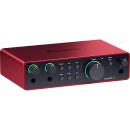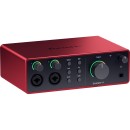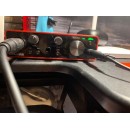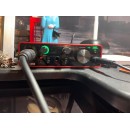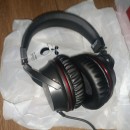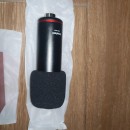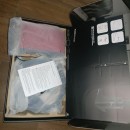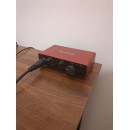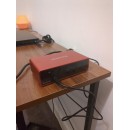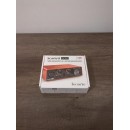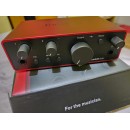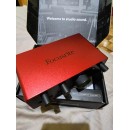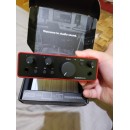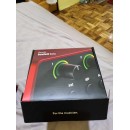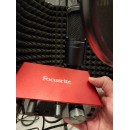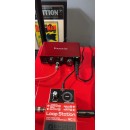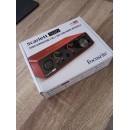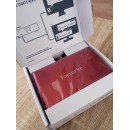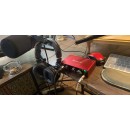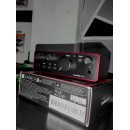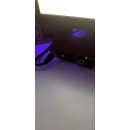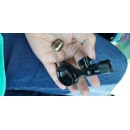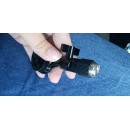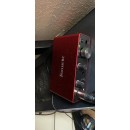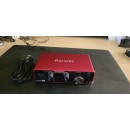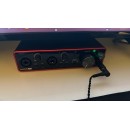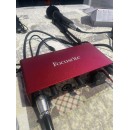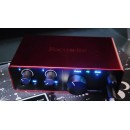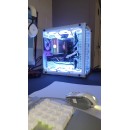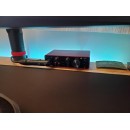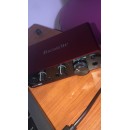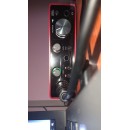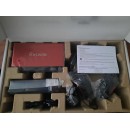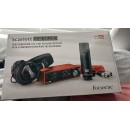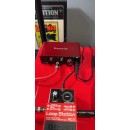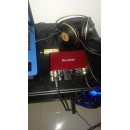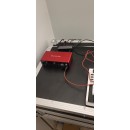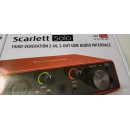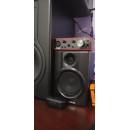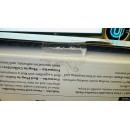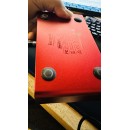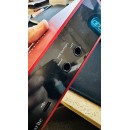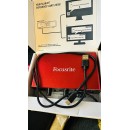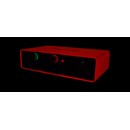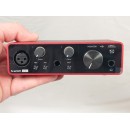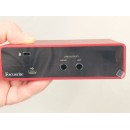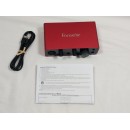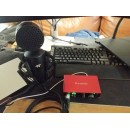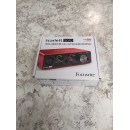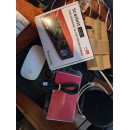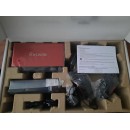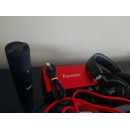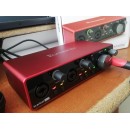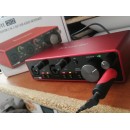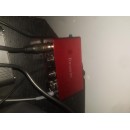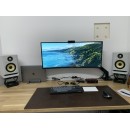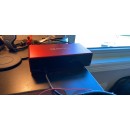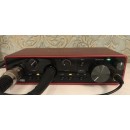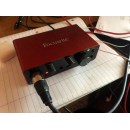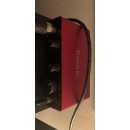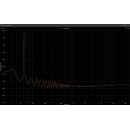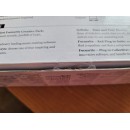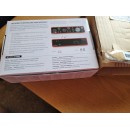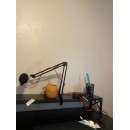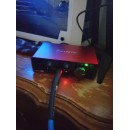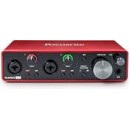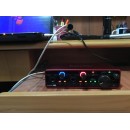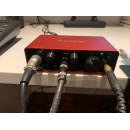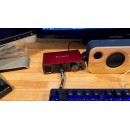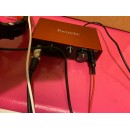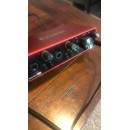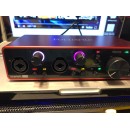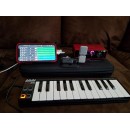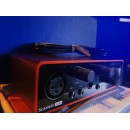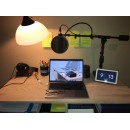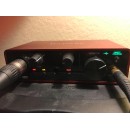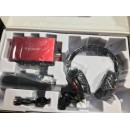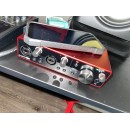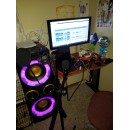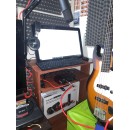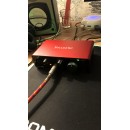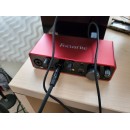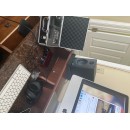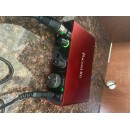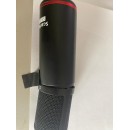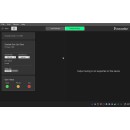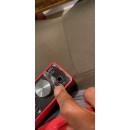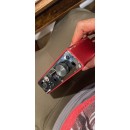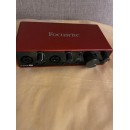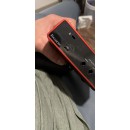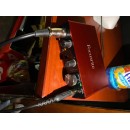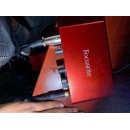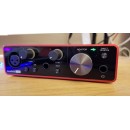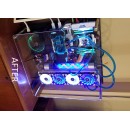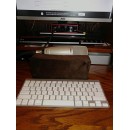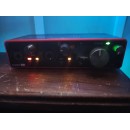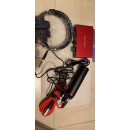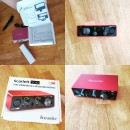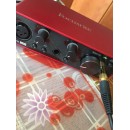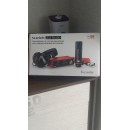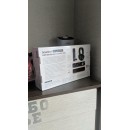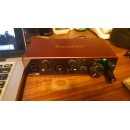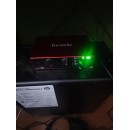Focusrite Scarlett 4i4 vs 2i2 USB-C Audio Interfaces (4th Generation): A Comprehensive Review
The Scarlett 2i2 is a compact and versatile 2-in/2-out interface, making it an ideal choice for solo artists, podcasters, and small home studios. It features two high-quality Scarlett mic preamps, a switchable Air mode for added brightness, and high-headroom instrument inputs. The 2i2 also offers 24-bit/192kHz AD-DA converters, ensuring pristine sound quality. The interface connects via USB-C, providing low latency and reliable performance. Its simplicity and ease of use make it perfect for beginners and professionals alike who need a straightforward solution for recording vocals and instruments.
On the other hand, the Scarlett 4i4 expands on the capabilities of the 2i2 by offering 4-in/4-out connectivity, making it suitable for more complex recording setups. It includes two Scarlett mic preamps with Air mode, just like the 2i2, but adds two additional line inputs and four balanced outputs. The 4i4 is also equipped with MIDI I/O, allowing seamless integration with MIDI controllers and other MIDI-enabled gear. This added flexibility makes the 4i4 a better choice for users who require more inputs and outputs, such as those working with multiple instruments or incorporating outboard gear into their setups. The 4i4's additional features come in a slightly larger form factor but still maintain a user-friendly interface.
Both interfaces are part of Focusrite's renowned Scarlett range, known for their durability, reliability, and high-quality audio performance. They come with a suite of software, including Ableton Live Lite, Pro Tools First, and a collection of plug-ins and virtual instruments, providing everything needed to start recording right out of the box. Whether choosing the Scarlett 2i2 for its simplicity and portability or the Scarlett 4i4 for its expanded connectivity and MIDI capabilities, users can expect excellent sound quality and performance from these fourth-generation interfaces.
Specifications, Advantages, and Disadvantages
| User Rating Based on Analysis of Reviews | |
|---|---|
|
Show More |
| Pros: | |
|---|---|
|
|
| Cons: | |
|---|---|
|
|
| Key Specs | |
|---|---|
| Channels of I/O | |
| Analog: 2 Inputs / 2 Outputs at 192 kHz |
Analog: 4 Inputs / 4 Outputs at 192 kHz |
| Maximum Sampling Rate | |
| 192 kHz / 24-Bit | 192 kHz / 24-Bit |
| Number of Microphone Inputs | |
| 2 | 2 |
| Analog Audio I/O | |
| 2x XLR 3-Pin Balanced Mic Input 2x 1/4" TRS Balanced/Unbalanced Line/Hi-Z Input (Front Panel) 2x 1/4" TRS Balanced Monitor Output 1x 1/4" TRS Headphone Output (Front Panel) |
2x Combo XLR-1/4" 3-Pin Balanced/Unbalanced Mic/Line/Hi-Z Input (Front Panel) 2x 1/4" TRS Balanced/Unbalanced Line Input 4x 1/4" TRS Balanced/Unbalanced Line/Monitor Output 1x 1/4" TRS Headphone Output (Front Panel) |
| Digital Audio I/O | |
| Host Connection | |
| 1x USB-C | 1x USB-C |
| OS Compatibility | |
| macOS Windows |
macOS Windows |
| Power Requirements | |
| USB Bus Power, USB Power Adapter (Not Included) | USB Bus Power, USB Power Adapter (Not Included) |
The Scarlett 2i2 offers 2 channels of I/O with analog inputs and outputs at a maximum sampling rate of 192 kHz and 24-bit resolution. It provides 2 microphone inputs through XLR 3-pin balanced mic inputs, along with 2 front-panel 1/4" TRS balanced/unbalanced line/Hi-Z inputs. For output, it has 2 rear-panel 1/4" TRS balanced monitor outputs and one front-panel 1/4" TRS headphone output. It connects to the host via USB-C and is compatible with macOS and Windows. It requires USB bus power or an optional USB power adapter.
In contrast, the Scarlett 4i4 expands the I/O capability to 4 analog inputs and 4 outputs at the same maximum sampling rate of 192 kHz and 24-bit resolution. It also includes 2 microphone inputs through combo XLR-1/4" balanced/unbalanced mic/line/Hi-Z inputs on the front panel. Additionally, it offers 2 rear-panel 1/4" TRS balanced/unbalanced line inputs and 4 rear-panel 1/4" TRS balanced/unbalanced line/monitor outputs. Similar to the 2i2, it has a front-panel 1/4" TRS headphone output. The Scarlett 4i4 also connects via USB-C and is compatible with macOS and Windows, requiring USB bus power or an optional USB power adapter.
Overall, the Scarlett 4i4 adds additional flexibility and connectivity options with its increased number of inputs and outputs, making it more suitable for users who need to handle more sources simultaneously. The Scarlett 2i2, with its more straightforward setup, is ideal for users who need fewer input and output channels.
| General | |
|---|---|
| Channels of I/O | |
| Analog: 2 Inputs / 2 Outputs at 192 kHz |
Analog: 4 Inputs / 4 Outputs at 192 kHz |
| Built-In DSP | |
| Maximum Sampling Rate | |
| 192 kHz / 24-Bit | 192 kHz / 24-Bit |
| Number of Microphone Inputs | |
| 2 | 2 |
| Built-In Microphone | |
| Input Level Adjustment | |
| 2x Knob | 2x Knob |
| Expansion Slots | |
However, the key difference between these two models lies in their channels of I/O. The Scarlett 2i2 offers 2 analog inputs and 2 analog outputs, which are suitable for simpler recording setups. In contrast, the Scarlett 4i4 expands on this capability with 4 analog inputs and 4 analog outputs, making it more versatile for users who require additional input and output options for more complex recording scenarios.
Both interfaces feature input level adjustments via two knobs, allowing users to fine-tune their input levels easily. Despite their similarities, the increased number of inputs and outputs in the 4i4 model provides a significant advantage for those needing to connect multiple instruments or audio sources simultaneously.
| Signal Processing | |
|---|---|
| Gain/Trim Range | |
| Mic/Line Inputs: Up to +69 dB Hi-Z Inputs: 62 dB |
Mic/Line Inputs: Up to +69 dB Hi-Z Inputs: 62 dB |
When it comes to Hi-Z Inputs, both the Scarlett 2i2 and Scarlett 4i4 offer a gain range of 62 dB. This ensures that both interfaces can effectively manage high-impedance instruments such as electric guitars and basses, providing the necessary headroom to accommodate dynamic performances without signal degradation.
In summary, both the Focusrite Scarlett 2i2 and Scarlett 4i4 (4th Generation) share identical specifications in terms of gain/trim range for both Mic/Line Inputs and Hi-Z Inputs. This similarity indicates that either device would be highly capable in a studio setting, delivering consistent performance across various audio recording scenarios.
| Connectivity | |
|---|---|
| Analog Audio I/O | |
| 2x XLR 3-Pin Balanced Mic Input 2x 1/4" TRS Balanced/Unbalanced Line/Hi-Z Input (Front Panel) 2x 1/4" TRS Balanced Monitor Output 1x 1/4" TRS Headphone Output (Front Panel) |
2x Combo XLR-1/4" 3-Pin Balanced/Unbalanced Mic/Line/Hi-Z Input (Front Panel) 2x 1/4" TRS Balanced/Unbalanced Line Input 4x 1/4" TRS Balanced/Unbalanced Line/Monitor Output 1x 1/4" TRS Headphone Output (Front Panel) |
| Phantom Power | |
| 48 V, Selectable On/Off | 48 V, Selectable On/Off |
| Digital Audio I/O | |
| Host Connection | |
| 1x USB-C | 1x USB-C |
| Host Connection Protocol | |
| USB 2.0 | USB 2.0 |
| USB (Non-Host) | |
| 1x USB-C (Power Input) | 1x USB-C (Power Input) |
| Sync I/O | |
| Network I/O | |
| MIDI I/O | |
|
1x DIN 5-Pin Input 1x DIN 5-Pin Output |
|
| Wireless | |
The Scarlett 2i2 is equipped with 2 analog audio inputs, both of which are XLR 3-Pin balanced mic inputs and 1/4" TRS balanced/unbalanced line/Hi-Z inputs located on the front panel. It also offers 2 analog audio outputs in the form of 1/4" TRS balanced monitor outputs and a single 1/4" TRS headphone output on the front panel. This interface is powered via a USB-C connection, utilizing the USB 2.0 protocol, and includes a separate USB-C port for power input. It supports 48V phantom power, which is selectable on or off. Notably, the Scarlett 2i2 lacks digital audio I/O, sync I/O, network I/O, and MIDI I/O capabilities, focusing mainly on straightforward audio recording and playback without additional connectivity options.
In contrast, the Scarlett 4i4 extends its capabilities with more versatile I/O options. It features 2 combo XLR-1/4" 3-Pin balanced/unbalanced mic/line/Hi-Z inputs on the front panel, alongside 2 additional 1/4" TRS balanced/unbalanced line inputs. The output options are enhanced with 4x 1/4" TRS balanced/unbalanced line/monitor outputs and a 1/4" TRS headphone output on the front panel. Like the 2i2, it supports 48V selectable phantom power and uses a USB-C connection with the USB 2.0 protocol for the host connection, along with a separate USB-C port for power input. A significant difference is the inclusion of MIDI I/O with 1x DIN 5-Pin input and 1x DIN 5-Pin output, enabling MIDI connectivity for users who need to integrate MIDI devices into their setup. However, similar to the 2i2, it does not feature digital audio I/O, sync I/O, or network I/O.
In summary, while both interfaces share some core functionalities, the Scarlett 4i4 offers additional inputs, outputs, and MIDI I/O, making it more suitable for users who require greater connectivity and flexibility in their audio and MIDI setups. The Scarlett 2i2, on the other hand, is more streamlined and focused on basic audio recording and playback needs, ideal for those who need a simple and effective interface without the extra connectivity options.
| Performance | |
|---|---|
| Frequency Response | |
| XLR Mic Inputs: 20 Hz to 20 kHz ±0.06 dB 1/4" Line Inputs: 20 Hz to 20 kHz 0.05 dB 1/4" Hi-Z Inputs: 20 Hz to 20 kHz 0.15 dB |
Combo XLR-1/4" Mic Inputs: 20 Hz to 20 kHz ±0.06 dB Combo XLR-1/4" Line Inputs: 20 Hz to 20 kHz ±0.05 dB Combo XLR-1/4" Hi-Z Inputs: 20 Hz to 20 kHz ±0.15 dB 1/4" Line Inputs: 20 Hz to 20 kHz ±0.02 dB |
| Maximum Input Level | |
| XLR Mic: 16 dBu 1/4" Line: 22 dBu 1/4" Hi-Z: 12 dBu |
Combo XLR-1/4" Mic: 16 dBu Combo XLR-1/4" Line: 22 dBu Combo XLR-1/4" Hi-Z: 12 dBu 1/4" Line: 22 dBu |
| Maximum Output Level | |
| 1/4" Line: +16 dBu |
1/4" Line: +16 dBu |
| Headphone Output Power | |
| 1/4": 32 mW into 33 Ohms 22 mW into 300 Ohms |
1/4": 57 mW into 33 Ohms 27 mW into 300 Ohms |
| Impedance | |
| XLR Mic Inputs: 3 Kilohms 1/4" Line Inputs: 60 Kilohms 1/4" Hi-Z Inputs: 1 Megohms 1/4" Line Outputs: 100 Ohms 1/4" Headphone Outputs: < 50 Ohm |
Combo XLR-1/4" Mic Inputs: 3 Kilohms Combo XLR-1/4" Line Inputs: 60 Kilohms Combo XLR-1/4" Hi-Z Inputs: 1 Megohms 1/4" Line Inputs: 60 Kilohms 1/4" Line Outputs: 100 Ohms 1/4" Headphone Outputs: < 11 Ohm |
| Dynamic Range | |
| XLR Mic Inputs: 116 dBA 1/4" Line Inputs: 115.2 dBA 1/4" Hi-Z Inputs: 113 dBA 1/4" Line Outputs: 120 dB 1/4" Headphone: 112 dB (at 33 Ohms) 115 dB (at 300 Ohms) Digital A/D Converters: 120 dB Digital D/A Converters: 130 dBA |
Combo XLR-1/4" Mic Inputs: 116 dBA Combo XLR-1/4" Line Inputs: 115.5 dBA Combo XLR-1/4" Hi-Z Inputs: 113 dBA 1/4" Line Inputs: 115.5 dBA 1/4" Line Outputs: 120 dB 1/4" Headphone: 112 dB (at 33 Ohms) 115 dB (at 300 Ohms) Digital A/D Converters: 130 dB Digital D/A Converters: 130 dBA |
| THD+N | |
| XLR Mic Inputs: -100 dB (at 8 dB Gain) 1/4" Line Inputs: -100 dB (at 8 dB Gain) 1/4" Hi-Z Inputs: -80 dB (at Minimum Gain) 1/4" Line Outputs: -109 dB 1/4" Headphone Outputs: -99 dB (at 33 Ohms) -108 dB (at 300 Ohms) Digital A/D Converters: -110 dB Digital D/A Converters: -115 dB |
Combo XLR-1/4" Mic Inputs: -100 dB (at 8 dB Gain) Combo XLR-1/4" Line Inputs: -100 dB (at 8 dB Gain) Combo XLR-1/4" Hi-Z Inputs: -80 dB (at Minimum Gain) 1/4" Line Inputs: -105 dB 1/4" Line Outputs: -112 dB 1/4" Headphone Outputs: -99 dB (at 33 Ohms) -108 dB (at 300 Ohms) Digital A/D Converters: -115 dB Digital D/A Converters: -115 dB |
| EIN | |
| XLR Mic Inputs: -127 dBu A-Weighted |
Combo XLR-1/4" Mic Inputs: -127 dBu A-Weighted |
Frequency Response: The Scarlett 2i2 offers a frequency response of 20 Hz to 20 kHz across its XLR mic inputs, 1/4" line inputs, and 1/4" Hi-Z inputs, with slight variations in accuracy ranging from ±0.06 dB to ±0.15 dB. The Scarlett 4i4 similarly covers 20 Hz to 20 kHz for its combo XLR-1/4" mic, line, and Hi-Z inputs and 1/4" line inputs, with accuracy variations of ±0.02 dB to ±0.15 dB.
Maximum Input Level: Both devices have similar maximum input levels. The Scarlett 2i2 supports up to 16 dBu for XLR mics, 22 dBu for 1/4" line inputs, and 12 dBu for 1/4" Hi-Z inputs. The Scarlett 4i4 maintains these levels for its combo XLR-1/4" mic, line, and Hi-Z inputs, with an additional 22 dBu for its 1/4" line inputs.
Maximum Output Level: Both interfaces boast a maximum output level of +16 dBu for their 1/4" line outputs.
Headphone Output Power: The Scarlett 2i2 provides 32 mW into 33 Ohms and 22 mW into 300 Ohms for its 1/4" headphone outputs. The Scarlett 4i4 offers significantly more power, with 57 mW into 33 Ohms and 27 mW into 300 Ohms.
Impedance: For impedance, the Scarlett 2i2 has an XLR mic input impedance of 3 Kilohms, 1/4" line input impedance of 60 Kilohms, 1/4" Hi-Z input impedance of 1 Megohms, 1/4" line output impedance of 100 Ohms, and 1/4" headphone output impedance of less than 50 Ohms. The Scarlett 4i4 matches these values for its mic, line, and Hi-Z inputs but has a lower 1/4" headphone output impedance of less than 11 Ohms.
Dynamic Range: Both interfaces offer a dynamic range of 116 dBA for mic inputs, around 115 dBA for line inputs, and 113 dBA for Hi-Z inputs. The Scarlett 2i2 features a 1/4" line output dynamic range of 120 dB and headphone outputs of 112 dB (at 33 Ohms) and 115 dB (at 300 Ohms). The Scarlett 4i4 matches these headphone output dynamic ranges but provides a slightly higher A/D converter range of 130 dB compared to the Scarlett 2i2's 120 dB.
THD+N: For total harmonic distortion plus noise (THD+N), both interfaces exhibit -100 dB for mic and line inputs at 8 dB gain and -80 dB for Hi-Z inputs at minimum gain. The Scarlett 2i2 offers -109 dB for 1/4" line outputs and -99 dB (at 33 Ohms) and -108 dB (at 300 Ohms) for 1/4" headphone outputs. The Scarlett 4i4 has slightly better figures for line outputs at -112 dB, with identical headphone output values.
EIN: Both interfaces have an equivalent input noise (EIN) of -127 dBu A-weighted for their mic inputs.
Overall, while both the Scarlett 2i2 and Scarlett 4i4 share many similarities, the Scarlett 4i4 offers additional functionalities such as higher headphone output power and slightly improved dynamic range specifications for digital converters, making it a more versatile choice for users who require more robust audio and MIDI capabilities.
| Digital Audio | |
|---|---|
| Sample Rates | |
| 44.1 / 48 / 88.2 / 96 / 176.4 / 192 kHz | 44.1 / 48 / 88.2 / 96 / 176.4 / 192 kHz |
| Bit Depths | |
| 24-Bit | 24-Bit |
| Sync Sources | |
| Internal | Internal |
Despite these similarities, the two models cater to different needs. The Scarlett 2i2 is designed with simplicity and ease of use in mind, making it ideal for solo artists or small setups that require two inputs and two outputs. Meanwhile, the Scarlett 4i4 offers greater flexibility with its additional inputs and outputs, as well as MIDI capabilities, which makes it a better fit for more complex recording environments or users who need to integrate MIDI hardware into their workflow.
| Audio Storage & Playback | |
|---|---|
| Media/Memory Card Slot | |
Both the Scarlett 2i2 and 4i4 are part of Focusrite's well-regarded Scarlett series, known for their high-quality audio performance and user-friendly design. However, their lack of media/memory card slots underscores their primary function as computer-connected devices, focusing on real-time audio recording, processing, and MIDI interfacing rather than standalone recording.
In summary, the Focusrite Scarlett 2i2 and 4i4 (4th Generation) do not differ in terms of media/memory card slot availability, as both models do not include this feature. This design choice aligns with their intended use for direct USB-C connectivity to computers for audio and MIDI interfacing.
| Compatibility | |
|---|---|
| OS Compatibility | |
| macOS Windows |
macOS Windows |
| Mobile App Compatible | |
| Yes: iPadOS Only | Yes: iPadOS Only |
In terms of operating system compatibility, both the Scarlett 2i2 and the Scarlett 4i4 support macOS and Windows. This ensures that users on both major desktop platforms can integrate these interfaces into their existing setups without issue. The identical OS compatibility also means that users can switch between these models without having to worry about different software or driver requirements.
Regarding mobile app compatibility, both interfaces support iPadOS. This makes them suitable for use with iPads, allowing for a more portable and versatile recording solution. This feature caters to musicians and producers who may prefer or need the convenience of mobile recording environments.
In summary, the Focusrite Scarlett 2i2 and Scarlett 4i4 (both 4th Generation) offer identical OS and mobile app compatibility features. These shared specifications ensure that users can expect robust support whether they are working on macOS, Windows, or iPadOS platforms.
| Power | |
|---|---|
| Power Requirements | |
| USB Bus Power, USB Power Adapter (Not Included) | USB Bus Power, USB Power Adapter (Not Included) |
| AC/DC Power Adapter | |
| 5 VDC at 900 mA | 5 VDC at 3 A (Included) |
| Power Consumption | |
| 4.5 W | 7.5 W |
Both interfaces can be powered via USB bus power or a USB power adapter. However, the Focusrite Scarlett 2i2 requires a 5 VDC power adapter at 900 mA, whereas the Focusrite Scarlett 4i4 demands a higher current with a 5 VDC power adapter at 3 A, which is included with the 4i4 but not with the 2i2. This difference in power requirements indicates that the 4i4 is designed to handle more complex tasks and possibly more connected devices, given its higher power consumption.
In terms of power consumption, the Scarlett 2i2 uses 4.5 W, while the Scarlett 4i4 consumes 7.5 W. This higher power consumption in the 4i4 further suggests a more robust and feature-rich interface, capable of supporting additional functionalities such as MIDI input/output, which is not available on the 2i2.
In summary, while both the Focusrite Scarlett 2i2 and 4i4 can be powered via USB or an external adapter, the 4i4 is designed to handle more demanding setups with its higher current requirement and power consumption. The inclusion of the power adapter with the 4i4 also adds convenience for users who might need the extra power for additional features.
| Physical | |
|---|---|
| Dimensions | |
| 7.1 x 4.6 x 1.87" / 18 x 11.7 x 4.75 cm | 7.09 x 5.08 x 2.32" / 18.01 x 12.9 x 5.89 cm |
| Weight | |
| 1.3 lb / 595.0 g | 1.8 lb / 816.0 g |
These differences in size and weight may influence the portability and space requirements for each interface, with the Scarlett 2i2 being more compact and lightweight, potentially making it more suitable for mobile setups or smaller workspaces. The Scarlett 4i4, while slightly larger and heavier, offers additional connectivity options that might appeal to users needing more versatility in their audio and MIDI interface.
| Packaging Info | |
|---|---|
| Package Weight | |
| 1.9 lb | 3.185 lb |
| Box Dimensions (LxWxH) | |
| 8.2 x 7 x 2.6" | 11.2 x 8 x 3.6" |
On the other hand, the Scarlett 4i4 has a package weight of 3.185 lb and box dimensions of 11.2 x 8 x 3.6 inches. This indicates that it is heavier and larger in size compared to the 2i2. These differences in weight and size may affect portability and storage considerations for potential users.
| Customer Images | |
|---|---|
| Videos | |
|---|---|
|
|
|
